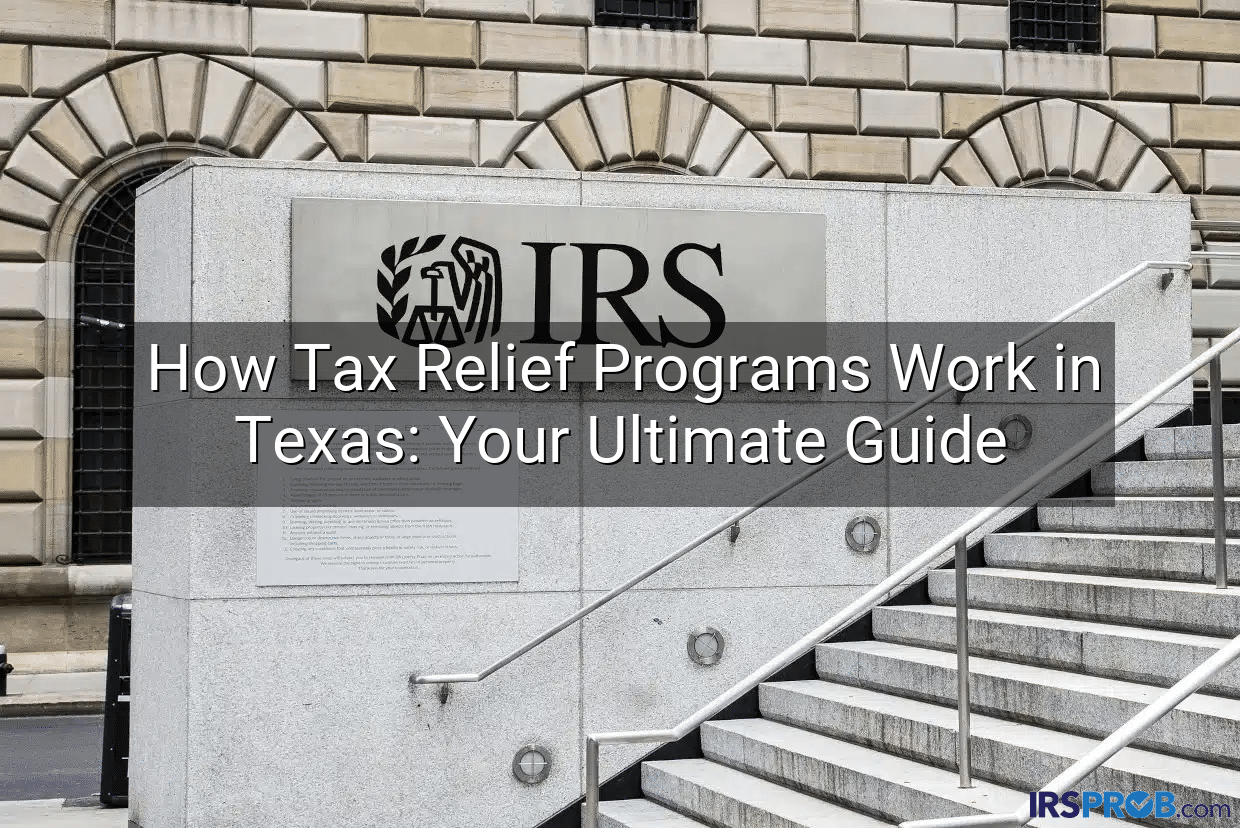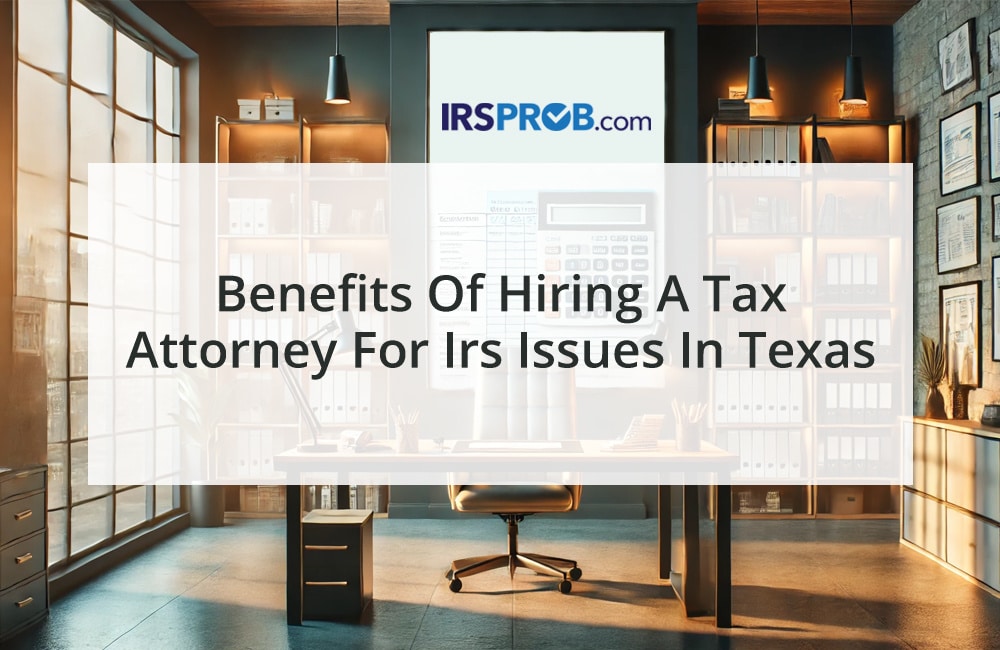Understanding Tax Relief Texas Programs: An Overview
Tax relief in Texas encompasses a variety of programs designed to assist residents and business owners who are burdened with high tax liabilities. These programs are developed with the purpose of reducing tax liabilities, offering payment plans, and even providing direct financial assistance in some cases. In the sprawling economic landscape of Texas, where property taxes and state obligations continue to rise, understanding these relief programs is crucial for many individuals struggling to keep up with tax obligations.
The state of Texas has taken significant steps to educate its residents about the available tax relief options. These programs range from property tax exemptions for the elderly and disabled to tailored support solutions for small business owners. With a growing emphasis on fiscal responsibility and financial well-being, the tax relief texas programs guide is intended to demystify these complex relief protocols, empowering Texans with the knowledge needed to secure their financial future.
This comprehensive guide delves into the multifaceted world of tax relief in Texas, explaining everything from basic eligibility requirements to the nuances of the application processes. For those facing mounting tax bills or simply seeking strategies to optimize their overall tax planning, understanding this guide is the first step toward financial recovery and stability.
Eligibility Criteria for Tax Relief in Texas
The first step in accessing any tax relief program is understanding who qualifies. Eligibility criteria can vary depending on the nature of the program and the specific needs it targets. In Texas, eligibility may be based on factors such as income levels, age, disability status, and even the value of the property owned. Precise definitions and guidelines are routinely updated by state and local authorities, making it essential that applicants are well-informed about current requirements.
Many programs are designed with the intention of providing support to the most vulnerable populations. For example, seniors often benefit from property tax exemptions, while low-income families may qualify for additional forms of relief. On the other hand, business owners who face operational challenges or unforeseen financial setbacks can also apply for payment deferrals or reduction in tax liabilities. This multifaceted approach ensures that assistance is available to various community segments, each facing unique financial hurdles.
The IRS Prob team in Texas continuously monitors changes in eligibility guidelines. They work with local government agencies to provide real-time updates and personalized advice based on an individual’s circumstances. As the economic environment evolves, keeping abreast of these changes is critical. Applicants are encouraged to verify their eligibility through official state and IRS resources before submitting any applications to avoid delays or potential rejections.
Navigating the Application Process for Tax Relief Texas Programs
Understanding eligibility is just the beginning—the next crucial stage is the application process. The process of applying for tax relief in Texas involves multiple steps, from gathering documentation to interacting with state or local tax authorities. For many, this process can seem overwhelming, which is why following a structured guide can streamline the journey.
Applicants must first compile all necessary documentation, including income statements, property assessments, and any previous correspondence with tax authorities. Organized records not only accelerate the processing of your application but also help in the event of any disputes or follow-up inquiries. Furthermore, many tax relief programs require additional forms of verification, such as proof of residency or an affidavit of financial hardship, to evaluate the legitimacy of the claim.
In the digital age, several online portals have been developed to assist Texans in applying for tax relief. These platforms provide step-by-step instructions, automated forms, and an interface to check the status of submissions. Additionally, local tax advisors and professionals from IRS Prob in Texas are available to guide applicants through the labyrinth of forms and legal jargon, ensuring that every detail is attended to. With thorough preparation and expert guidance, the application process can be significantly less daunting.
Benefits and Long-Term Impacts of Tax Relief Programs
Participating in tax relief programs offers immediate benefits to applicants, such as reduced tax payments and extended payment deadlines. However, the advantages extend far beyond the short-term financial relief. Tax relief programs contribute significantly to long-term financial stability and planning, creating an environment where taxpayers can reallocate funds for essential investments and savings.
An essential benefit of these programs is the alleviation of financial stress. When taxpayers are not constantly burdened by high tax obligations, they can experiment with investment strategies, property improvements, and other long-term financial goals. This creates a potential upward cycle where improved personal financial health can lead to better credit scores and more favorable loan terms, benefiting the broader economy in Texas.
Furthermore, tax relief programs often come bundled with educational initiatives that empower applicants to make smarter financial decisions in the future. Workshops, webinars, and personalized consultations provided by professionals at IRS Prob help Texans to understand complex financial regulations, ultimately leading to more informed decision-making. In many cases, participants not only achieve immediate tax relief but also gain the competence to manage their finances more effectively, ensuring long-lasting benefits.
Common Challenges and How to Overcome Them
While tax relief programs provide valuable support, applicants often encounter several challenges during the process. One of the primary issues faced is the complexity of regulatory requirements and documentation. Inadequate or incorrect paperwork can lead to delays in processing or even rejection of an application, potentially worsening the taxpayer’s situation.
Another significant challenge is navigating the frequently changing landscape of tax laws and relief guidelines in Texas. With policy updates occurring at regular intervals, keeping up with the latest information is essential but can be laborious for individuals who are not well-versed in tax regulations. Many applicants find themselves overwhelmed by the vast amount of paperwork and the time-consuming nature of the application process.
To overcome these hurdles, it is highly recommended to seek expert guidance from professionals who specialize in tax relief, such as the IRS Prob team in Texas. These experts can offer personalized advice to ensure that all documentation is complete and accurate. Additionally, utilizing online resources and attending informational sessions can help applicants stay current with the latest regulatory changes. By investing in a well-organized approach and professional help, many of the common challenges can be mitigated effectively.
Real-Life Success Stories: Tax Relief in Action
Success stories play a pivotal role in illustrating the real-life benefits of tax relief programs. Through numerous accounts from Texans who have successfully navigated the complexities of tax relief, the tangible impact of these programs becomes clear. Many homeowners and business owners have overcome their financial obstacles and transformed their fiscal standing thanks to dedicated support and well-structured tax relief initiatives.
One such success story involves a small business owner in Houston who struggled to keep up with rising property taxes. By accessing the tax relief programs tailored for businesses, he was able to secure both immediate tax relief and long-term payment plans that allowed his business to invest more in growth and innovation. The ability to reinvest saved funds into developing infrastructure and expanding operations is a testament to the transformative power of these programs.
Similarly, many seniors in rural parts of Texas have seen their quality of life improve dramatically after applying for property tax exemptions. These successes highlight how targeted support can provide vulnerable populations with the financial breathing room needed to enjoy a more secure retirement. By sharing these stories, the tax relief texas programs guide not only underscores the financial benefits but also offers hope and inspiration to individuals still in the process of applying.
Key Strategies for Optimizing Your Tax Relief Investment
To maximize the benefits derived from tax relief programs, it is essential to adopt strategic financial planning techniques. This part of the tax relief texas programs guide focuses on key strategies that can help you optimize your tax relief investment while planning for a secure financial future. The strategies outlined here are based on years of experience and success stories from Texans who have reaped the benefits of well-planned fiscal management.
One of the primary strategies is to maintain up-to-date documentation and a proactive approach to communication with tax authorities. By ensuring that all records are thoroughly organized and kept current, you can avoid unnecessary delays in the processing of your tax relief application. This proactive measure also allows for quicker redressal of any discrepancies or issues that may arise during verification.
Another strategy is to integrate the tax relief programs into your overall financial planning. Tax relief should not be viewed merely as a temporary fix but as a part of a broader financial strategy. By working with financial advisors, many of whom have expertise in Texas tax law, you can develop a comprehensive plan that includes budgeting, savings, and investment strategies. This multifaceted approach can help you leverage the benefits of tax relief into long-term financial resiliency.
Finally, staying engaged with legislative updates and policy changes is crucial. Tax laws are subject to frequent modifications, and staying informed will allow you to adapt your strategies accordingly. Consider subscribing to newsletters, attending workshops, or participating in local forums that discuss financial management and tax regulations. Informed taxpayers are empowered taxpayers, and this knowledge is a valuable asset in optimizing your tax relief investment.
Additional Considerations for Homeowners and Business Owners
The tax relief programs in Texas are not one-size-fits-all; they vary depending on whether you are a homeowner or a business owner. Each category has unique considerations that can substantially affect your approach to applying and benefiting from these programs. Understanding these differences is crucial for tailoring the best strategy according to your specific needs.
For homeowners, tax relief typically revolves around property taxes. Programs geared toward homeowners often include exemptions for seniors, disabled individuals, veterans, and in some cases, low-income families. Homeowners should keep abreast of changes in local valuations, as well as any modifications in exemption criteria. Regularly reviewing property assessments and consulting with local authorities can help ensure that you are maximizing any potential relief.
Business owners, on the other hand, may deal with complexities that extend beyond property taxes. They must consider aspects such as sales tax obligations, business personal property tax, and other financial liabilities. The integration of tax relief into broader business planning can assist in reducing operational costs and alleviating financial strain during challenging times. Entrepreneurs are encouraged to maintain a close relationship with tax professionals, not only to manage their daily fiscal responsibilities but also to benefit from the specialized tax relief programs available to the business community.
Future Trends in Tax Relief Programs in Texas
As economic and regulatory environments evolve, so too will tax relief programs. The future of tax relief in Texas is expected to witness significant changes, driven by technological advancements, legislative reforms, and shifting economic circumstances. This section of the tax relief texas programs guide examines the potential future trends that could reshape how tax relief is administered and accessed in Texas.
One anticipated trend is the increased use of digital platforms for application and management of tax relief. With state initiatives aimed at digitizing records and processes, future applicants can expect a more streamlined, efficient system that reduces paperwork and processing times significantly. This shift is expected to improve transparency and accountability, thereby increasing public trust in the tax relief system.
Another trend is the potential broadening of eligibility criteria to include more diverse populations. As Texas continues to experience rapid demographic changes, policymakers are increasingly considering adjustments in relief programs to accommodate a broader spectrum of taxpayers. Future legislative initiatives may introduce new categories of eligibility, ensuring that tax relief reaches more individuals and businesses in need.
Lastly, there is a growing focus on the integration of tax relief with comprehensive financial wellness programs. This trend suggests that future tax relief programs will not only focus on immediate financial alleviation but also on educating and empowering taxpayers for long-term financial security. Enhanced collaboration between state agencies, financial institutions, and community organizations is likely to be a key feature of this evolution.
Pro Tips from IRS Prob
Pro Tip #1: Stay Organized and Document Everything
Keeping detailed records and documents can be the key to a smooth application process. Create a checklist of all necessary paperwork, including income statements, appraisal documents, and previous tax communications. Regularly update your records, and organize them digitally for easy access. This diligent approach not only speeds up the process but also helps in case of any inconsistencies during verification.
Pro Tip #2: Leverage Professional Support
Tax laws and regulations can be complex, so consider partnering with experienced tax advisors or financial planners. Professionals at IRS Prob specialize in tax relief Texas programs and can offer you personalized advice tailored to your situation. Their expertise can help you navigate changes in eligibility criteria and stay updated on policy reforms that could further benefit your application.
Pro Tip #3: Stay Informed and Proactive
Regularly monitor updates from state tax authorities and subscribe to Texas tax newsletters. Attend local workshops and webinars focused on tax relief and financial management. Being proactive in staying informed can equip you with strategies to adjust to any shifts in tax policy, ensuring that you always maximize the potential benefits of tax relief programs.








